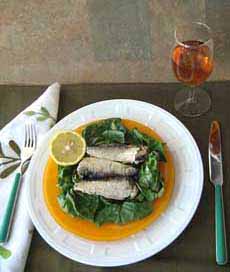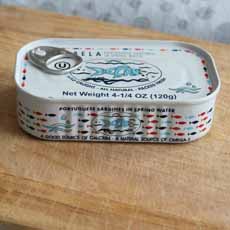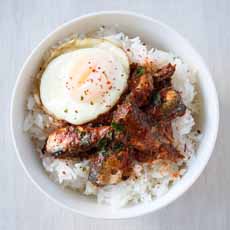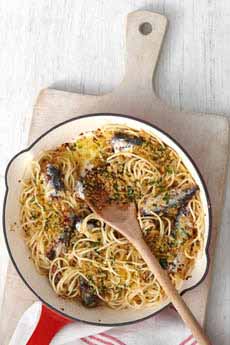TOP PICK OF THE WEEK: Bela Sardines & Mackerel
|
|
Earlier in our life, we did not care at all for sardines. We turned up our nose at this “cat food.” That’s because what was available in supermarkets then was of pretty low quality. Many Americans grew up eschewing sardines.
Often, those undesirables weren’t even sardines, but sprats—a different genus, Sprattus in the same family as sardines. They are less tasty cousins of sardines. To add to the confusion, sprats are sometimes called brisling sardines, after a canned variety from Norway. The sought-after European sardine, also called the pilchard sardine (photo #1), is species Sardina pilchardus Walbaum. You won’t find those words on a can: You have to know the best brands. Now we’ve become a foodie nation, and grocers are offering the world’s best. In sardines, that’s the BELA brand. They’re a boon for Mediterranean and Paleo Diet followers, as well as for anyone wanting a quick meal with quality protein. Check out the way we enjoy them, below. And did we mention they’re just $3 a can? The premium quality “gourmet” sardines from Bela Brands (photos #2, #3 and #4) have found their way into many foodie homes. The company also sells premium canned mackerel fillets and skipjack tuna in jars; but given the number of words in this article alone, we’ll have to feature them another time. BELA Brand Seafood is a family-owned business which has been sustainably fishing the southern coast of Portugal, the Algarve, for generations. The large, juicy, delicious Portuguese sardines have been the main crop in this region for centuries. BELA lays claim to be the best canned sardine there is: You can eat them at every meal of the day. _Eggs Benedict à la Portugal. _On buttered toast or avocado toast. _On a grilled vegetable sandwich, with optional mozzarella. _With a glass of wine at brunch or cocktails (see photos #5 and #6). _We top Finn Crisp flatbread with sardines and pickled onions. _Place pieces on toothpicks and serve with beer and wine. _Add a piece to a cucumber slice, cracker or toast point. |
|
|
_First course: on an individual crudité plate, like a Greek mezze plate, along with pita, olives and optionally, hummus or babaganoush. _Salad: Toss pieces with a green salad, or create a sophisticated plating with endive and/or radicchio. _Main course: on pasta, with good olive oil as the sauce (add olives, scallions, parsley—anything else you like—and top with toasted breadcrumbs). |
||
|
SARDINES HISTORY Sardines are small, oily fish within the herring family of Clupeidae, ray-finned fishes, important, nutrient-rich food fishes comprising, among others, herrings, sardines, shads and whitebait. They are also important for fish oil and fish meal—and as food for larger marine denizens. Sardines are found around the globe today, although all sardines originally came from somewhere in Europe. The name “sardine” first appears in English in the early 15th century. Some historians say it may be named for the Mediterranean island of Sardinia, around which sardines were once abundant. There are four genera of sardines, the two most important of which are: Canned sardines were a staple of millions of soldiers fighting both world wars. They sustained thousands of workers—the fishermen and packers of Cannery Row in Monterey, California, during the worst years of the Depression [source]. Similarly, they provided important fish protein to ravaged parts of Europe. Canning is a relatively recent innovation. In 1795, Nicolas Appert, a Parisian chef and confectioner, began to experiment with conserving foods, without altering their flavor or texture. He ultimately developed a process using a glass jar, similar to boiling the contents in a Mason jar. In 1810, British inventor and merchant Peter Durand patented his own method, using a tin can [source]. So, canned sardines have been available to export for a bit more than 200 years—and they very high quality and expensive: “gourmet” fare. But with the Industrial Revolution (from the mid-18th to the mid-19th centuries) things began to change. Fishing grounds became polluted, and some business practices—like labeling sprats as sardines—transpired to create those less-than-pleasing cans of sardines. Good news: The Portuguese Algarve has no industry, and the ocean waters are clean. That’s another reason BELA sardines taste so good. Here’s more on the history of sardines. Check our local markets, or head online to: |
 [7] Sardines top wilted greens(photo Emily Chang | © THE NIBBLE).
|
|
|
FRESH SARDINES: IN STORES NOW! The Portuguese sardine season runs from May through October (sardines from other waters have their own seasons). In season fresh sardines even more wonderful, grilled, pickled or smoked. Grilled sardines fresh sardines with potatoes, bread and a salad are a popular summer meal in Portugal—and will be a revelation to you if you keep an eye out for them. Sushi lovers: head to the sushi bar! Raw sardine nigiri is a treat!
|
||










